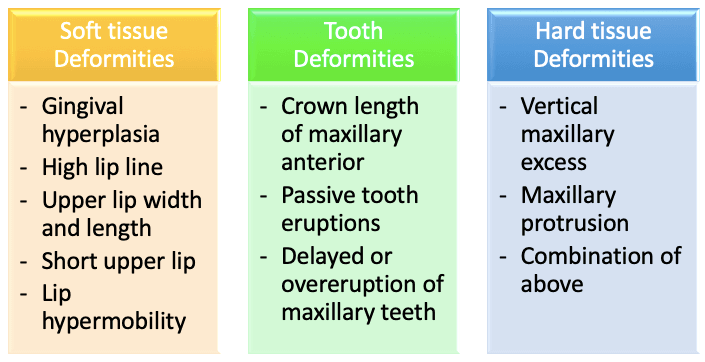Introduction
Gummy smile is excessive gingival appearance during smiling. It is a major esthetic concern in young people. Gingival display of more than 4 mm is generally considered unesthetic. Prevalence of gummy smile is 7% in males and 14% in females, as reported according to a face aesthetic survey.
Ideal smile
For an ideal smile appearance, a normal gingival display between inferior border of upper lip and gingival margins of maxillary anterior teeth, during a posed smile, should be 1 to 2 mm only.
Etiology of gummy smile
Etiology of gummy smile is multifactorial including soft tissue excess and hard tissue excess. Unesthetic smile appearance also includes dental malalignments and gingival overgrowth.

(Chart 1: Etiology of gummy smile)
Treatment options
Surgical esthetic procedure is always art work. Treatment of gummy smile depends on etiology, perceptions and expectations of patients along with surgical esthetic limitations.
- Gingivectomy
- Crown lengthening
- Lip repositioning
- Orthodontics
- Prosthetic tooth positioning
- Botox
- Orthognathic surgery
Surgical strategic treatment planning

(Flow chart 1 : Etiology and treatment options relationship)
Surgical procedures for gummy smile correction
1) Gingivectomy
Gingival hyperplasia is a common etiology for gummy smile. Gingival hyperplasia can be effectively treated with gingival reshaping and gingivectomy surgery. When marginal gingiva is more than 2 mm, then gingivoplasty should be considered.
Steps:
- Surgery can be done under maxillary local anesthesia.
- Then bleeding points can be marked with a marker/probe and the points can be joined to prepare a line of excision.
- After that, an external bevel gingivectomy incision should be placed, in the anterior region on the facial surface only, using surgical blade no 15, placed 45° angle to the tooth’s long axis, apically to the bleeding points.
- Then, forceps with the help of Orban knife can be used to remove the excised gingival segment.
- Afterwards, the gingiva should be contoured and scraped to remove residual tissue tags.
- Finally, a periodontal dressing should be applied to gingiva.

(Image 1: Gingivectomy for gummy smile management )
2) Crown lengthening with osteoplasty
For maxillary anterior short crown cases, this procedure is useful.
Steps:
- After local anesthesia for maxilla, a full thickness mucoperiosteal flap should be raised.
- Then the desired vertical osteoplasty required interdentally can be done.
- Gingival flap repositioning with sutures can be done.
- Osteoplasty underneath the gingival flap is key to prevent gingival relapse.

(Image 2: Crown lengthening for gummy smile correction)
3) Lip repositioning
Lip repositioning is a simple surgical procedure to treat gummy smile. The procedure restricts the muscle pull of the elevator lip muscles, thereby reducing the gingival display while smiling.With the help of this procedure, 4 to 5 mm gummy smile can be corrected. Surgery can be done for upper lip reposition only.
Steps:
- Lip repositioning surgery can be planned under local anesthesia.
- After local anesthesia, the surgical site should be marked with an indelible pencil, from maxillary right first molar to maxillary left first molar vestibular mucosa.
- A partial thickness flap should be raised from mesial line angle of left maxillary first molar to the mesial line angle of right maxillary first molar at the mucogingival junction.
- A second incision, 10–12 mm above the first incision, should be made in the labial mucosa.
- The two incisions should be joined on either side and a strip of partial thickness flap should be removed, exposing the underlying connective tissue .
- The two incisions should then be approximated using continuous interlocking sutures.

(Image 3: Lip repositioning surgery)
4) Orthognathic surgery (Maxillary Superior positioning)
Most often, gummy smile is of alveolo-skeletal origin: basal, alveolar or a combination of the two. This is due to excessive vertical growth of the maxilla or superior alveolar bone, causing discrepancy between the upper lip and gum line in spontaneous smiling. For vertical maxillary bone excess and gummy smile more than 5 to 10 mm, ideal treatment will be orthognathic surgery. Maxillary Le Forte 1 procedure is performed.
Steps:
- Under general anesthesia, maxillary degloving incision should be placed and a full thickness mucoperiosteal flap should be raised.
- Complete maxilla should be exposed.
- Osteotomy with rotary bur instrument should be planned from nasal bone level to posterior maxilla.
- Then, downward maxillary fracture should be done with Rowe’s forceps.
- The desired 5 mm to 10 mm bone segment should be removed and maxillary fixation with titanium plates should be done.
For dental and occlusal correction post surgery, orthodontics is required.

(Image 4: Maxillary superior positioning with orthognathic surgery )

(Image 5 : Maxillary osteotomy for excess bone removal )

(Image 6: internal fixation with titanium plates after osteotomy)
Non surgical procedures for gummy smile correction
1) Botox (Botulinum toxin type A)
A gummy smile can easily and effectively be treated with Botox injections. The best part of this treatment is, its non invasive and quick procedure. Botox has botulinum toxin type A, and when injected, it can relax the muscles in the upper lip and limit the rise of the upper lip when smiling, so the gums will remain covered.
Steps:
- Two or more units of Botox (Botulinum toxin type A) are used.
- They are injected in the area between the nose and upper lip to reduce the appearance of any “gummy” smile, creating a more appealing and natural smile.
- Its result last up to 3 to 4 months after which it can be re-injected.

(Image 7: Botox injection points for gummy smile)
2) Prosthetic option
Prosthetics play an important role during treatment of gummy smile. Veneers or crowns can make the teeth appear longer and improve the tooth-to-gum ratio if the teeth are too short.
It can also be a part of mixed treatment protocol with gingivectomy and crown lengthening procedures.

(Image 8: prosthetic treatment for gummy smile )
Gummy smile correction results
- Allows your teeth to be the focus while you smile, no excessive gum display
- Exposes more teeth more evenly
- Enhances fullness of the upper lip
- Creates a smile that looks relaxed
- Helps achieve harmony and balance between your smile and the rest of your face
- Improves confidence and reduces the fear/hesitancy to smile.

(Image 9: post surgery end result : no excessive gum display)
DISCUSSION
Facial aesthetics is an area of concern now a days. Smile plays a vital role in the attractiveness of face. Consideration of a nice smile depends and changes from person to person. Still, over exposed gums while smiling is not appreciated. Management of gummy smile was tried in past era with various surgical and non surgical options. But clear guidelines for width of exposed gingiva and treatment procedure was not uniformly explained.
A smile is considered as attractive when maxillary teeth are entirely shown with 1 mm of gingiva only. However, gingival disply up to 3 mm is acceptable. More than 3 mm of gingival exposure is considered as non esthetic and requires treatment. As I have explained earlier in flowchart no 1 –
- Gummy smile up to 4 mm exposure can be treated with gingivectomy or crown lengthening or both.
- 3 mm to 5 mm gummy smile with upper short lip or hypermobility can be treated with lip reposition surgery.
- Lip reposition surgery can be used as combination treatment with gingivectomy or crown lengthening.
- Passive eruption and dental malalignment needs to treated with orthodontic procedure.
- Gummy smile due to vertical maxillary excess and bone deformities needs to be corrected with orthognathic surgery.
- Prosthetic dental rehabilitation and botox to be considered as non surgical treatment options only.
Conclusion
Despite availability of new advances in management of gummy smiles, surgical management with gingivectomy, crown lengthening, lip repositioning and orthognathic bone surgery are to be considered with planning for permanent results.
References
- Excessive gingival display–etiology, diagnosis, and treatment modalities. Silberberg N et al Quintessence Int. 2009; 40: 809-818
- Surgical Correction of the “Gummy Smile”, Jairo A. Bastidas, DMD Published21 DOI:https://doi.org/10.1016/j.coms.2021.01.005
- The aesthetic smile: Diagnosis and treatment. Garber DA, Salama MA. Periodontol 2000. 1996;11:18–28.
- The diagnosis and treatment of the gummy smile. Levine RA, McGuire M. Compend Contin Educ Dent. 1997;18:757–62
- An evaluation of the influence of gingival display level in the smile esthetics. Suzuki L, Machado A, Bittencourt M. Dental Press J Orthod. 2011 Oct;16(5):37.e1–37.10




















Comments